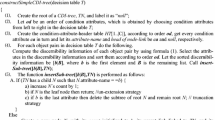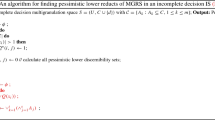Abstract
Covering rough sets, which generalize traditional rough sets by considering coverings instead of partitions, are introduced to deal with set-valued, missing-valued or real-valued data sets. For decision systems with such kinds of data sets, attribute reduction with covering rough sets aims to delete superfluous attributes, and fast algorithms of finding reducts are clearly meaningful for practical problems. In the existing study of attribute reduction with covering rough sets, the approach of discernibility matrix is the theoretical foundation. However, it always shares heavy computation load and large store space because of finding and storing all elements in the discernibility matrix. In this paper, we find that only minimal elements in the discernibility matrix are sufficient to find reducts. This fact motivates us in this paper to develop algorithms to find reducts by only employing minimal elements without computing other elements in the discernibility matrix. We first define the relative discernible relation of covering to characterize the relationship between minimal elements in the discernibility matrix and particular sample pairs in the covering decision system. By employing this relative discernible relation, we then develop algorithms to search the minimal elements in the discernibility matrix and find reducts for the covering decision system. Finally, experimental comparisons with other existing algorithms of covering rough sets on several data sets demonstrate that the proposed algorithms in this paper can greatly reduce the running time of finding reducts.


Similar content being viewed by others
References
Bianucci D, Cattaneo G, Ciucci D (2007) Entropies and co-entropies of coverings with application to incomplete information systems. Fundam Inf 75:77–105
Chen DG, Wang CZ, Hu QH (2007) A new approach to attribute reduction of consistent and inconsistent covering decision systems with covering rough sets. Inf Sci 177:3500–3518
Chen DG, Zhao SY, Zhang L, Yang YP, Zhang X (2012) Sample pair selection for attribute reduction with rough set. IEEE Trans Knowl Data Eng 24(11):2080–2093
Chen DG, Zhang L, Zhao SY, Hu QH, Zhu PF (2012) A novel algorithm for finding reducts with fuzzy rough sets. IEEE Trans Fuzzy Syst 20(2):385–389
Chen DG, Li WL, Zhang X, Kwong S (2014) Evidence-theory-based numerical algorithms of attribute reduction with neighborhood-covering rough sets. Int J Approx Reason 55(3):908–923
Couso I, Dubois D (2011) Rough sets, coverings and incomplete information. Fundam Inf 108:223–247
Sakai H, Okuma A (2004) Basic algorithms and tools for rough non-deterministic information analysis. Trans Rough Sets I, LNCS 3100:209–231
Hu J, Wang G, Zhang Q (2006) Uncertainty measure of covering generated rough set. In: Proceedings of the 2006 IEEE/WIC/ACM international conference on Web Intelligence and Intelligent Agent Technology, IEEE Computer Society pp 498–504
Hu QH, Yu DR, Liu JF, Wu CX (2008) Neighborhood rough set based heterogeneous feature subset selection. Inf Sci 178:3577–3594
Hu J, Wang GY (2013) Uncertainty problem processing with covering generalized rough sets. Rough Sets Intell Syst, ISRL 43:293–308
Kotlowski W, Blaszczynski J, Greco S, Slowinski R (2008) Stochastic dominancebased rough set model for ordinal classification. Inf Sci 178:4019–4037
Kryszkiewicz M (1998) Rough set approach to incomplete information system. Inf Sci 112(1–4):39–49
Li F, Yin YQ (2009) Approaches to knowledge reduction of covering decision systems based on information theory. Inf Sci 179:1704–1794
Liu GL, Sai Y (2009) A comparison of two types of rough sets induced by coverings. Int J Approx Reason 50:521–528
Nakata M, Sakai H (2008) Rough sets approximations in data tables containing missing values. In: Proceedings of FUZZY-IEEE 2008, IEEE Press, pp 673–680
Ma LW (2012) On some types of neighborhood-related covering rough sets. Int J Approx Reason 53:901–911
Miao DQ, Zhang N, Yue XD (2009) Knowledge reduction in interval-valued information systems. In: Proceedings of the 8th IEEE International Conference on Cognitive Informatics, pp 320–327
Newman DJ, Hettich S, Merz CL (1998) UCI Machine Learning Repository, University of California, Department of Information and Computer Sciences, Irvine, CA, 1998. http://www.ics.uci.edu/_mlearn/MLRepository
Pawlak Z (1982) Rough sets. Int J Comput Inform Sci 11:341–356
Pomykala JA (1987) Approximation operations in approximation space. Bull Polish Acad Sci 35:653–662
Samanta P, Chakraborty MK (2009) Covering based approaches to rough sets and implication lattices, Rough Sets, Fuzzy Sets, Data Mining and Granular Computing, Springer Berlin Heidelberg, pp 127–134
Shi ZH, Gong ZT (2010) The further investigation of covering-based rough sets: uncertainty characterization, similarity measure and generalized models. Inf Sci 180:3745–3763
Skowron A, Rauszer C (1992) The discernibility matrices and functions in informa-tion systems. In: Slowinski R (ed) Intelligent decision support-handbook ofapplications and advances of rough sets theory. Kluwer Academic Publishers, Boston, pp 331–362
Stefanowski J, Tsoukias A (2001) Incomplete information tables and rough classification. Comput Intell 17(3):545–566
Stefanowski J, Tsoukias A (2001) Valued tolerance and decision rules. In: Ziarko W, Yao Y (eds) Rough sets and current trends in computing, Springer Verlag, LNAI 2005, Berlin, pp 212–219
Tsang ECC, Chen DG, Yeung DS, Wang XZ, Lee JWT (2008) Attributes reduction using fuzzy rough sets. IEEE Trans Fuzzy Syst 16(5):1130–1141
Vanderpooten D (1997) Similarity relation as a basis for rough approximations. Adv Machine Intell Soft Comput 4:17–33
Wang J, Wang J (2001) Reduction algorithms based on discernibility matrix: the ordered attributes method. J Comput Sci Technol 16:489–504
Wang LJ, Yang XB, Yang JY, Wu C (2012) Relationships among generalized rough sets in six covering and pure reflexive neighborhood system. Inf Sci 207:66–78
Wang CZ, Chen DG, Sun BQ, Hu QH (2012) Communication between information systems with covering based rough sets. Inf Sci 216:17–33
Wang CZ, He Q, Chen DG, Hu QH (2014) A novel method for attribute reduction of covering decision systems. Inf Sci 254:181–196
Wang CZ, Du WJ (2010) On covering rough set based attribute reduction. In: 2010 Second WRI Global Congress on Intelligent Systems, Wuhan, pp 96–99
Wang CZ, Shao MW, Sun BQ, Hu QH (2015) An improved attribute reduction scheme with covering based rough sets. Appl Soft Comput 26:235–243
Xu WH, Zhang WX (2007) Measuring roughness of generalized rough sets induced by a covering. Fuzzy Sets Syst 158:2443–2455
Yang T, Li QG, Zhou BL (2013) Related family: a new method for attribute reduction of covering information systems. Inf Sci 228:175–191
Yang T, Li QG (2010) Reduction about approximation spaces of covering generalized rough sets. Int J Approx Reason 51:335–345
Yang Y, Chen DG, Dong Z (2014) Novel algorithms of attribute reduction with variable precision rough set model. Neurocomputing 139:336–344
Yao YY, Zhao Y (2009) Discernibility matrix simplification for constructing attribute reducts. Inf Sci 179:867–882
Yao YY, Yao BX (2012) Covering based rough set approximations. Inf Sci 200:91–107
Yun ZQ, Ge X, Bai XL (2011) Axiomatization and conditions for neighborhoods in a covering to form a partition. Inf Sci 181:1735–1740
Zakowski W (1983) Approximations in the space (U, Π). Demonstr Math 16:761–769
Zhu W, Wang FY (2007) On three types of covering rough sets. IEEE Trans Knowl Data Eng 19:1131–1144
Zhu W (2009) Relationship among basic concepts in covering-based rough sets. Inf Sci 179:2478–2486
Zhang YL, Luo MK (2011) On minimization of axiom sets characterizing covering- based approximation operators. Inf Sci 181:3032–3042
Zhang YL, Li JJ, Wu WZ (2010) On axiomatic characterizations of three pairs of covering based approximation operators. Inf Sci 180:274–287
Zhang X, Mei CL, Chen DG, Li JH (2013) Multi-confidence rule acquisition oriented attribute reduction of covering decision systems via combinatorial optimization. Knowl-Based Syst 50:187–197
Zhang X, Mei CL, Chen DG, Li JH (2014) Multi-confidence rule acquisition and confidence-preserved attribute reduction in interval-valued decision systems. Int J Approx Reason 55:1787–1804
Zhu P (2011) Covering rough sets based on neighborhoods: an approach without using neighborhoods. Int J Approx Reason 52:461–472
Zhu W, Wang F-Y (2002) Some results on the covering generalized rough sets. Pattern Recognit Artif Intell 5:6–13
Zhu W, Wang F (2003) Reduction and axiomization of covering generalized rough sets. Inf Sci 152:217–230
Zhu W (2007) Topological approaches to covering rough sets. Inform Sci 177:1892–1915
Zhu W (2009) Relationship between generalized rough sets based on binary relation and covering. Inf Sci 179:210–225
Zhu W, Wang FY (2012) The fourth type of covering-based rough sets. Inf Sci 201:80–92
Zhu P, Wen QY (2012) Entropy and co-entropy of a covering approximation space. Int J Approx Reason 53:528–540
Yu DR, Hu QH, Bao W (2004) Combining rough set methodology and fuzzy clustering for knowledge discovery from quantitative data. Proc Chin Soc Electr Eng 24(6):205–210
Yang XB, Yang JY (2012) Incomplete information system and rough set theory: models and attribute reductions. Springer, Berlin
Yang XB, Yu DJ, Yang JY, Wei LH (2009) Dominance-based rough set approach to incomplete interval-valued information system. Data Knowl Eng 68(11):1331–1347
Xu WH, Li Y, Liao XW (2012) Approaches to attribute reductions based on rough set and matrix computation in inconsistent ordered information systems. Knowl-Based Syst 27:78–91
Wang XZ, Eric CC, Tsang SY, Zhao DG, Chen D, Yeung S (2007) Learning fuzzy rules from fuzzy samples based on rough set techniques. Inf Sci 177:4493–4514
Wang XZ, Zhai JH (2008) S.X Lu, Induction of multiple fuzzy decision trees based on rough set technique. Inf Sci 178(16):3188–3202
Zhao SY, Wang XZ, Chen DG, Eric C, Tsang C (2013) Nested structure in parameterized rough reduction. Inf Sci 248:130–150
Acknowledgments
This paper is supported by grants of NSFC (71471060), and the Fundamental Research Funds for the Central Universities (JB2014204, 13ZD15, 12ZP13).
Author information
Authors and Affiliations
Corresponding author
Rights and permissions
About this article
Cite this article
Dong, Z., Sun, M. & Yang, Y. Fast algorithms of attribute reduction for covering decision systems with minimal elements in discernibility matrix. Int. J. Mach. Learn. & Cyber. 7, 297–310 (2016). https://doi.org/10.1007/s13042-015-0438-2
Received:
Accepted:
Published:
Issue Date:
DOI: https://doi.org/10.1007/s13042-015-0438-2




